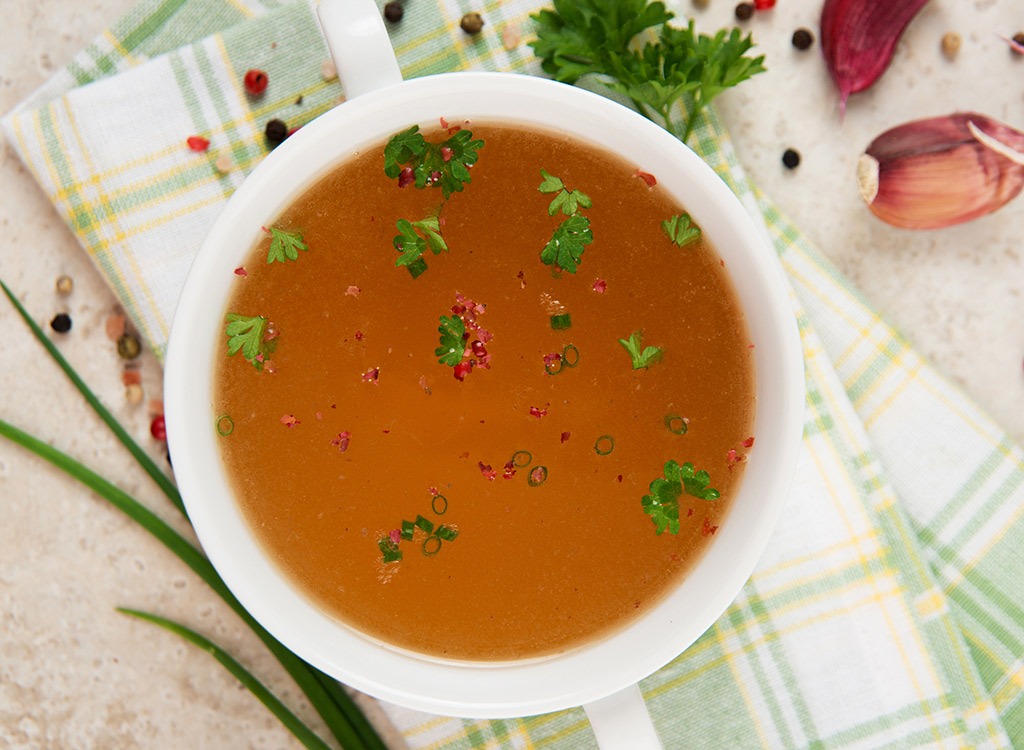Should You Be Sipping Bone Broth?

The other day my friend asked me if she could have a sip of my coffee. When I told her what was actually lurking in my to-go cup was bone broth, her face immediately transformed to one of utter horror. “Well, never mind then,” she said. “I definitely don’t want any of that…whatever the heck it is.”
The life of a health-nut can be rough sometimes. With each season comes a new—often odd-sounding trend—each one claiming to be the best solution to our nation’s collective health woes. Bone broth, which is made by slowly cooking animal bones in water until they break down, is no exception. The concoction slapped with the ever so off-putting name is the detox du jour, and fans of the sipped elixir claim it can ease everything from wrinkles to joint pain. I personally sip it because I like the taste (there isn’t much not to love about flavorful, warm soup), but hearing these claims got me thinking: Is the broth really a crazy-amazing superfood? Should I be guzzling by the gallon so I stay forever young and ache-free? Is it really the new kale? To get the answer to these questions and more, we turned to Lauren Slayton, MS RD, founder of Foodtrainers.
Before asking her about the broth’s benefits, I wanted to understand where the trend started. Similar to the revival of cropped leggings and sandals with socks (yes that actually was a big trend this year), boiling bones in water is nothing new but did recently have a major come back. “Some say prehistoric man cooked bones over a fire to render the nutrients. Although I cannot verify or dispute this, bone broth is definitely having its moment,” says Slayton. “Because it’s so warm and soothing, the appeal of the broth is heightened now during the cold and dreary months more than ever.” We’ll have to check back in July and see if it’s still as alluring. Beyond that, only time will tell if it has the same staying power as kale and other trendy health foods.
Speaking of low-calorie, nutrient-packed kale, how does bone broth stack up to the dietary champion? Although people have dubbed bone broth both a “miracle drink” and “liquid gold,” the health benefits—like many other health foods of the moment—are a bit over-stated. “Although bone broth is certainly healthy and worth seeking out, sipping it once will not do much more than taste good,” explains Slayton. “However, if you sip about eight ounces a day and follow a diet rich in whole foods and low in added sugar and white flour you can certainly reap the benefits,” she explains.
Let’s Take a Closer Look the Three Primary Ways it Can Boost Your Health:
It improves nutrient absorption.
When animal bones are boiled to make the broth, their collagen is broken down into gelatin and extracted into the water. “When we ingest it, it acts as an intestinal Band-Aid, protecting and healing the lining of the digestive tract which aids digestion and helps us absorb extra nutrients from the foods we eat,” explains Slayton.
It diminishes joint and cartilage pain.
Gelatin is not only beneficial for the belly, but may also strengthen bones and joints and relieve pain brought on by age-related arthritis and joint deterioration. Slayton also notes that the broth is rich in glucosamine, a naturally occurring chemical that people often take in supplement form to fight cartilage and joint issues. More research needs to be done to better understand the effectiveness of glucosamine..
It can ease a hangover.
“I wouldn’t tell my clients to go out and get hammered and then drink bone broth,” Slayton jokes, “however, the broth is anti-inflammatory and a good source of minerals so it does make for a decent ‘morning after’ remedy.”
Interested in swapping your green juice for bone broth to reap the benefits? There are few different ways to get in on the trend. The healthiest but most time consuming way is to make the broth yourself. Although there’s not much prep involved it does take 12 to 24 hours to cook, says Slayton. Yes, we know that’s a long time, however Slayton explains that the extended duration in the pot is what helps break the collagen down into gelatin, where most of the “magical” health benefits of the broth lie. Interested in giving it a go? Ask your local butcher for a couple pounds of large marrow bones and some meaty ones as well. “It’s crucial that you request the organic grass-fed variety, as pesticides are stored in the fat of conventionally raised animals,” warns Slayton. Besides the bones, the healthiest recipes will include ingredients like water, apple cider vinegar, vegetables and spices and little else. If the recipe you find is having you throw excess ingredients into the pot, find another one.
If you’d rather not get in touch with your inner Martha Stewart, buying a pre-made broth is also an option. If you’re in New York City, pop over to the East Village broth bar, Brodo, owned by Marco Canora, a “Next Iron Chef” alum. He offers the soup in various flavors and serves it in cardboard to-go cups. Fair warning though, the broths cost up to $9 a cup. Those in the Portland area can get a bowl of broth from the Cultured Caveman for $4 to $6 dollars a pop.
If you can’t find a restaurant brewing up broth near you, Pacific Bone Broths make for a decent alternative and can be found at grocery and health food stores. “They may not have as much gelatin as homemade varieties since Pacific aimed to make their broths a bit thinner, however they are still a great source of low-calorie protein and, since they come in a box, there is no concern of BPA contamination,” says Slayton.
MELT UP TO 10 POUNDS IN ONE WEEK!
WITH OUR BEST-SELLING NEW DIET PLAN, The 7-Day Flat-Belly Tea Cleanse! Test panelists lost up to 4 inches from their waist! Available now in paperback!
